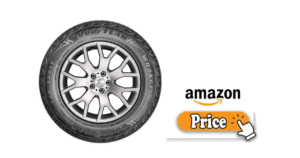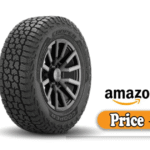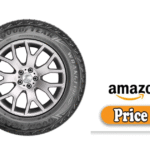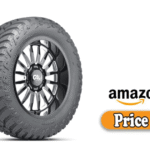Choosing the right tire brand can mean the difference between a confident drive and a risky ride. Whether you’re navigating wet highways, snow-covered backroads, or just cruising through your daily commute, your tires are your first line of safety and performance.
That’s why many drivers are searching for the best Goodyear tires for their vehicle. Founded in 1898, Goodyear is one of the most recognized and respected tire brands in the world. Known for innovation, durability, and versatility, Goodyear produces tires for virtually every vehicle and condition.
But with such a wide range of options, which Goodyear tires are truly the best? In this in-depth article, we’ll explore the best Goodyear tires available today. We’ll also dive into what makes them stand out, what could be better, my personal experience with Goodyear products, and comparisons with alternatives.
Whether you’re driving a sedan, truck, SUV, or performance car, this guide will help you confidently answer the question: What are the best Goodyear tires for me?
What I Like About Goodyear Tires
Goodyear’s reputation is built on more than just marketing. Here’s what makes the brand stand out:
1. Reliable All-Season Performance
Goodyear has long excelled in creating versatile tires that perform well across all seasons. Models like the Assurance WeatherReady and Eagle Sport All-Season are engineered to adapt to changing road conditions, providing consistent traction and stability in dry, wet, and even snowy environments.
2. Advanced Technology
Goodyear continually invests in innovation. Their Weather Reactive Technology, 3D TredLock, and ActiveBraking systems are not just marketing terms; they improve traction, braking, and stability. If you’re looking for cutting-edge tire tech, Goodyear delivers.
3. Long-Lasting Tread Life
With several models boasting warranties of up to 85,000 miles, Goodyear tires are known for their durability. This makes them an economical long-term choice, even if the upfront cost is a bit higher.
4. Noise Reduction and Comfort
Goodyear places a heavy focus on ride quality and cabin quietness. The Assurance ComfortDrive line is designed specifically for a smoother, more refined ride ideal for long road trips or daily highway driving.
5. Safety Ratings and Reviews
Many Goodyear tires rank highly in independent safety tests from organizations like Consumer Reports and Tire Rack. Wet braking, cornering grip, and hydroplaning resistance are all strong suits for the brand.
What Could Be Better
No brand is perfect, and Goodyear has a few areas that could use improvement:
1. Premium Price Tags
Goodyear tires often come at a higher price point compared to competitors like Firestone, Hankook, or Cooper. While the quality often justifies the price, it can be a hurdle for budget-conscious buyers.
2. Tread Noise in Some Models
While Goodyear offers several quiet tire lines, some models, particularly high-performance or all-terrain types, can produce noticeable road noise as they age.
3. Dry Traction in All-Season Models
Some all-season models may sacrifice dry-road grip for wet or snow capability. For example, the Assurance WeatherReady is excellent in snow and rain but doesn’t corner as confidently on dry roads compared to a dedicated performance tire.
4. Winter-Specific Performance
Goodyear’s winter tire options (like the Ultra Grip series) are good, but they don’t always outperform dedicated winter leaders like Nokian or Bridgestone’s Blizzak in extreme cold conditions. 👉🏿👉🏻 Check the Latest Price and Offer at Amazon 👈🏻👈🏿
👉🏿👉🏻 Check the Latest Price and Offer at Amazon 👈🏻👈🏿
My Personal Experience with Goodyear Tires
Over the years, I’ve driven on various Goodyear models across multiple vehicles, including a compact sedan, a mid-size SUV, and a light-duty pickup truck. One model that particularly stood out to me is the Goodyear Assurance WeatherReady.
Initial Impressions
After installing the WeatherReady tires, I immediately noticed an increase in grip, especially in the rain. The tires felt responsive, and I didn’t experience the slipping or skidding I had with my previous generic brand tires.
Performance Over Time
After 30,000+ miles, the tread wear was minimal, and the performance stayed consistent. I appreciated the quiet ride and confidence in light snow and slushy conditions. Rotations were done every 6,000–7,000 miles, and alignment was checked regularly.
Customer Service and Warranty
I purchased the tires from a certified Goodyear retailer, and the limited treadwear warranty was honored without any issues. The peace of mind that comes with reputable brand support is a real value-add.
Design: Engineering That Matters
Goodyear’s tire design emphasizes safety, comfort, and adaptability, catering to various driving styles and environments.
Tread Patterns
Goodyear’s engineers design complex tread geometries that serve different functions. For example:
- Weather Reactive Channels adapt to wet and snowy conditions.
- Asymmetric patterns in performance tires like the Eagle F1 improve cornering.
- Wide circumferential grooves in models like Wrangler TrailRunner evacuate water efficiently.
Sidewall Strength
Goodyear’s sidewalls are well-constructed and generally resistant to minor damage from potholes and curbs. The Durawall Technology in Goodyear’s off-road tires resists cuts and punctures in rough terrain.
Rubber Compounds
Their proprietary rubber blends offer a strong mix of flexibility (for wet and winter grip) and stiffness (for dry handling). Silica-infused compounds help improve wet traction and reduce rolling resistance for better fuel economy.
Performance: How Do the Best Goodyear Tires Drive?
1. Dry Road Handling
Goodyear performance tires, particularly the Eagle F1 Asymmetric, are known for precise steering, tight cornering, and rapid braking. For sporty driving or high-speed highway cruising, they offer a confident and composed experience.
2. Wet Road Performance
Goodyear’s wet traction is impressive across the board. Even their affordable Assurance All-Season models handle wet roads with poise. Hydroplaning resistance is a strong point thanks to deep water evacuation grooves.
3. Snow and Ice
The Assurance WeatherReady and Ultra Grip Ice WRT offer strong traction in wintery conditions. Though not quite at the level of dedicated snow tires like Blizzak or Michelin X-Ice, they perform admirably for all-season or winter-rated tires.
4. Ride Comfort
Models like the Assurance ComfortDrive are specially designed for noise reduction and ride softness. You can feel the cushioning even on rough pavement, ideal for comfort-seeking drivers.
5. Off-Road Capability
Goodyear’s Wrangler All-Terrain Adventure and Duratrac models are excellent choices for trucks and SUVs that hit the trails. They’re rugged, stable, and versatile on gravel, mud, and snow alike.
Build Quality: The Goodyear Standard
Goodyear doesn’t just market safety; it builds it in.
Manufacturing and Testing
With U.S.-based manufacturing facilities and a global supply chain, Goodyear tires undergo extensive testing for durability, pressure integrity, and heat resistance.
Their testing centers simulate a variety of real-world driving conditions to ensure quality and consistency.
Tread Life
Goodyear tires consistently last between 50,000 to 85,000 miles, depending on the model and driving habits. The Assurance MaxLife is one of the top contenders, designed for longevity and consistent tread wear.
Warranty Support
Most Goodyear tires come with robust warranties, often including:
- Limited Treadwear Warranty
- Free tire replacement within 12 months
- Road hazard protection (optional)
- 30-day satisfaction guarantee
Puncture Resistance
Goodyear’s RunOnFlat technology is available in select models, allowing continued driving for up to 50 miles after a puncture, great for emergencies.
Alternative Options: How Goodyear Stacks Up
If you’re considering alternatives, here’s how Goodyear compares to other major brands:
1. Michelin
Pros: Superior ride quality, tread life, and premium engineering.
Cons: More expensive.
Verdict: Michelin wins in comfort and longevity, but costs more than Goodyear.
2. Bridgestone
Pros: Strong performance and wide model range.
Cons: Some models are stiff or noisy.
Verdict: Bridgestone offers more performance-oriented choices, but Goodyear is more comfort-focused.
3. Continental
Pros: Excellent wet performance and ride comfort.
Cons: Slightly lower treadwear ratings.
Verdict: Great if you drive in rainy regions; Goodyear is more all-around.
4. Pirelli
Pros: Stylish, performance-driven.
Cons: Lower tread life in some models.
Verdict: Best for sports cars, but Goodyear wins on practicality and durability.
Final Thought:
If you’re asking whether Goodyear tires are among the best on the market, the answer is a confident yes.
From daily commuters and family sedans to all-terrain SUVs and performance vehicles, Goodyear has a tire solution built for your driving style and environment. Their blend of safety, technology, comfort, and durability places them consistently among the top tire brands worldwide.
If you want a dependable tire with excellent real-world performance and don’t mind paying a bit more for long-term value, Goodyear is one of the best choices available.
FAQs: Best Goodyear Tires | My Honest Review
Q1: What are the best Goodyear tires for all-season driving?
The Goodyear Assurance WeatherReady is one of the top-rated all-season tires, offering dependable grip in wet, dry, and light snow conditions.
Q2: Are Goodyear tires quiet?
Yes, models like the Assurance ComfortDrive and Assurance MaxLife are specifically engineered for low road noise and a smooth ride.
Q3: How long do Goodyear tires last?
Depending on the model and driving conditions, Goodyear tires typically last between 50,000 to 85,000 miles.
Q4: Are Goodyear tires good for snow and ice?
Yes. The Ultra Grip Ice WRT and Assurance WeatherReady provide reliable winter traction. However, dedicated snow tires from Bridgestone or Nokian may outperform them in extreme conditions.
Q5: Are Goodyear tires expensive?
They are mid-to-high in price, but they offer good value due to durability, comfort, and safety features.
Q6: Is Goodyear better than Michelin?
Both brands are excellent. Michelin offers more in ride quality and longevity, while Goodyear excels in all-season versatility and affordability.
Q7: Do Goodyear tires come with a warranty?
Yes. Most Goodyear tires include limited treadwear warranties, a 30-day test drive guarantee, and optional road hazard protection.
Q8: Are Goodyear run-flat tires available?
Yes. Goodyear’s RunOnFlat technology allows you to drive up to 50 miles after a puncture.
Q9: Are Goodyear tires good for trucks and SUVs?
Absolutely. The Wrangler All-Terrain Adventure, Duratrac, and TrailRunner AT are excellent options for off-road and towing applications.
Q10: Where can I buy Goodyear tires?
Goodyear tires are widely available at Goodyear Auto Service, Discount Tire, Tire Rack, Costco, Walmart, and most local auto shops.




